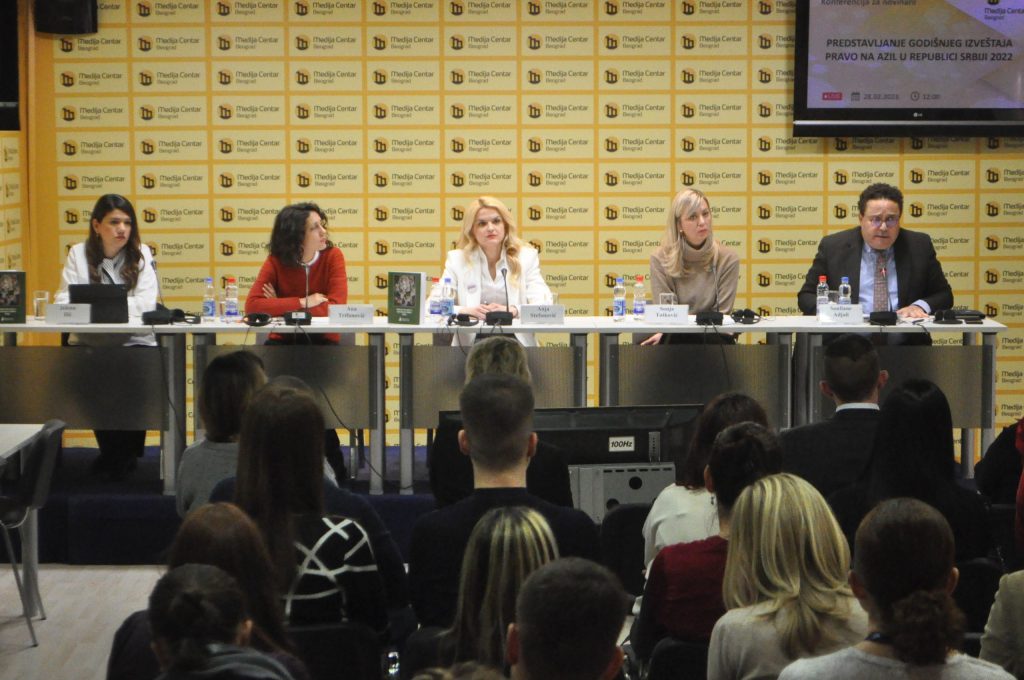1.3.2023.The Belgrade Centre for Human Rights (BCHR) presented its annual report Right to Asylum in the Republic of Serbia 2022 at a press conference in the Belgrade Media Centre on 28 February. The report was presented by UNHCR Representative in Serbia Soufiane Adjali, BCHR Executive Director Sonja Tošković, BCHR Asylum and Migration Programme Coordinator Anja Stefanović, Report Editor Ana Trifunović and BCHR Asylum and Migration Programme Senior Integration Adviser Jelena Ilić.
UNHCR data show that the number of people who had to flee armed conflict, persecution or natural disasters caused by climate change has quintupled in the past three decades and reached 103 million for the first time on record.

According to the data of the Serbian Commissariat for Refugees and Migration, over 119,000 refugees and asylum seekers stayed in the Serbian asylum and reception centres in 2022, or twice as many as in 2021, said the Report Editor, Ana Trifunović.
She ascribed the rise to the influx of refugees from Ukraine, as well as the evident increase in the number of refugees coming from Africa and the Middle East. Most of the refugees hailed from Afghanistan and Syria, and the number of people living in the asylum and reception centres averaged between four and eight thousand a month, she said.

Three hundred and twenty of the 4,181 individuals who expressed the intention to seek asylum in 2022 filed their asylum applications. The Asylum Office upheld 30 asylum applications during the reporting period, more than double than in 2021, when it upheld 14 claims. The Serbian authorities have upheld 238 asylum applications since 2008, said Ana Trifunović, adding that the data indicated that most people on the move still perceived Serbia as a transit, rather than as a destination country.
Serbia issued 1,115 rulings granting temporary protection mostly to Ukrainian nationals, in accordance with the temporary protection mechanism activated after Russia’s invasion of Ukraine, said Ana Trifunović. The border police at Belgrade Airport Nikola Tesla denied entry to 4,000 foreigners, including Syrian nationals; some of them may have been in need of international protection, she noted.

The war in Ukraine, Serbia’s harmonisation of its visa regime with the EU and the trilateral memorandum signed by Serbia, Hungary and Austria affected migration flows towards Serbia the most, said Asylum and Migration Programme Coordinator Anja Stefanović.
“The arrival of Ukrainian nationals in Serbia was facilitated by the visa-free regime and they applied for temporary protection on arrival. In BCHR’s experience, the application of the temporary protection mechanism was relatively smooth. The people who fled Ukraine mostly stayed in private lodgings and many of them have friends and relatives, even spouses, here. The Serbian Government designated the Vranje Asylum Centre for the accommodation of exclusively Ukrainian refugees,” she said, adding that most Ukrainian refugees wanted to return to their country as soon as circumstances permitted.

Anja Stefanović also recalled that Serbia abolished the visa-free regime with Tunisia, India and Burundi at the EU’s request and that there were apprehensions that it would introduce visas to other countries as well. Although not much is known about the Memorandum of Understanding between Austria, Hungary and Serbia on strengthening trilateral cooperation to curb illegal migration, the EU is obviously surrounding itself “with additional wires and fences”, which will just increase criminal human smuggling practices and human rights violations by states, said Anja Stefanović.
Anja also spoke about environmental refugees and people forcibly displaced by climate change and human devastation of the environment, warning that such a fate could befall Serbia as well, specifically “the Jadar River Valley, unless further lithium exploration and mining are prevented.”

Jelena Ilić, a Senior Integration Adviser with BCHR’s Asylum and Migration Programme, said that 230 refugees in 2022 asked BCHR to help them pursue their education or access the labour market in Serbia.
She said that BCHR in 2022 represented 94 Ukrainian clients, as well as clients from Burundi, Iran and Libya, in procedures for accessing their economic and social rights.
“Only 23% of the foreigners between 20 and 56 years of age who asked us to help them access their right to work or education spoke Serbian. Four BCHR’s clients have enrolled in Serbian colleges since 2021,” said Ilić.

BCHR Executive Director Sonja Tošković said that eight million people fled just Ukraine in 2022 and that 900,000 of them applied for asylum. However, Syria and Afghanistan remained one of the most important countries of origin of applicants for international protection in Europe, she noted.
“According to Frontex, most asylum seekers entered the EU legally with visas and only around 300,000 of them tried to enter the EU illegally,” said Tošković, adding that some countries have introduced stricter procedures for granting protection even to Ukrainians.

The Report is available at the following link: Right to Asylum in Serbia 2022
The Right to Asylum in the Republic of Serbia 2022 Report was prepared within the project Support to Refugees and Asylum Seekers in Serbia, which BCHR has been implementing with the support of the UNHCR Office in Serbia. As UNHCR’s partner, BCHR has been extending legal aid to asylum seekers and persons granted international protection in Serbia since 2012.

The video of the news conference at which the Right to Asylum in the Republic of Serbia 2022 report was presented is available at the following link:
